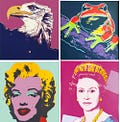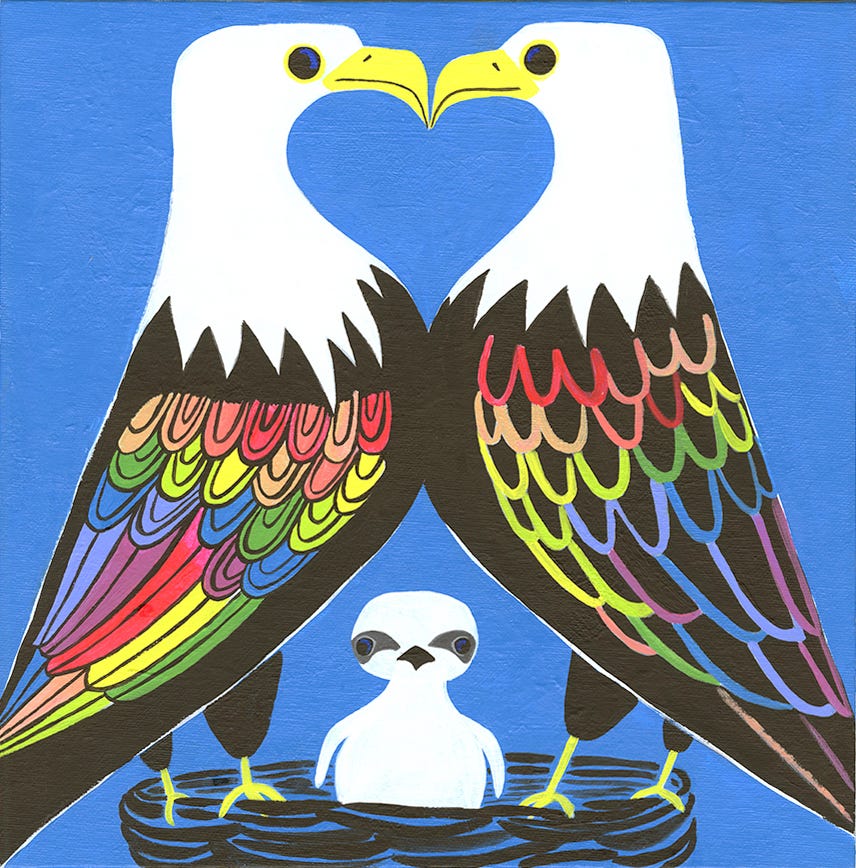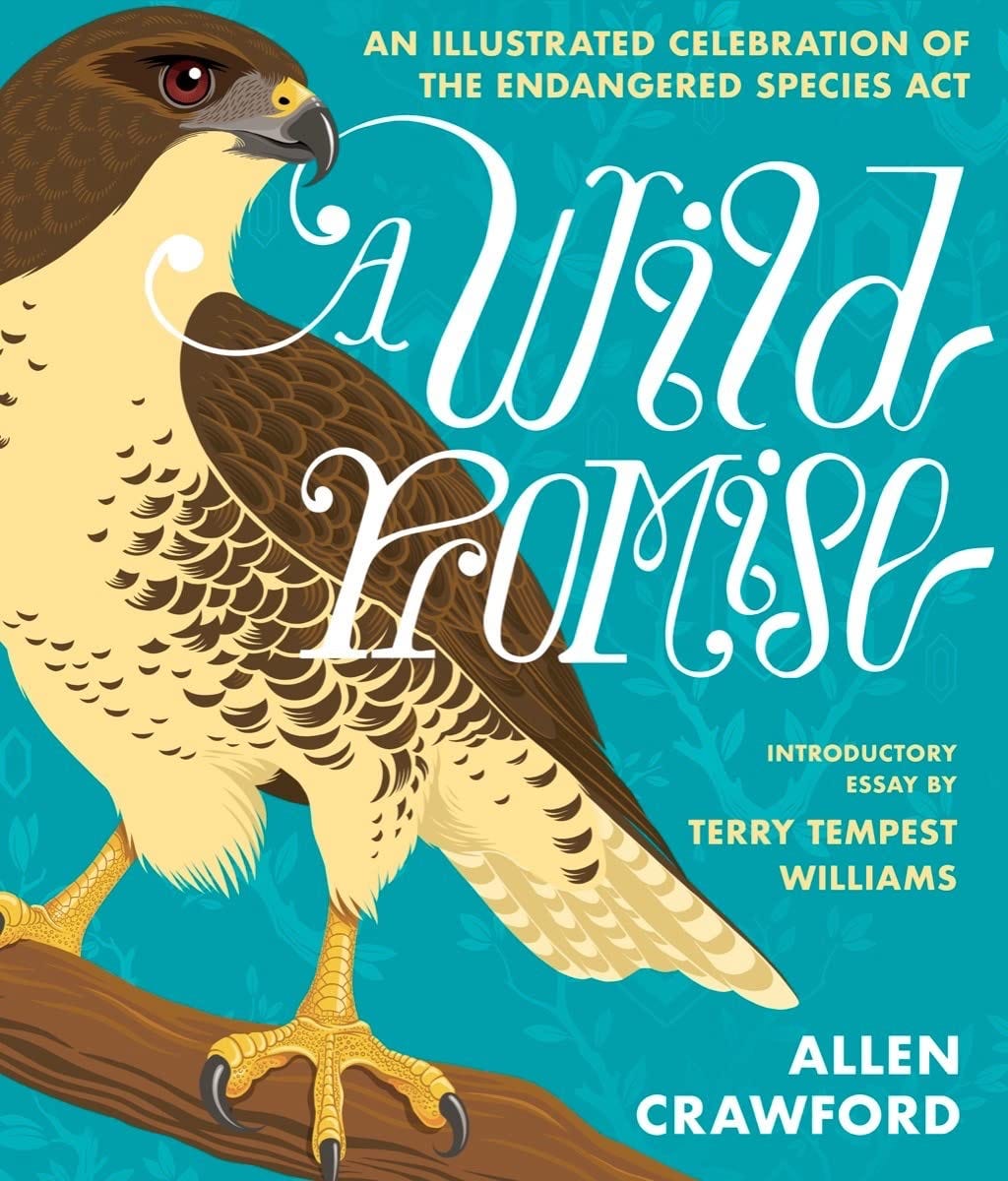In 1983, Andy Warhol was commissioned to paint ten of the world’s endangered species. In the style of his celebrity portraits, he depicted wildlife with the same reverence as Marilyn Monroe and Queen Elizabeth II. With these portraits, he immortalized two New Jersey residents—the bald eagle and the Pine Barren’s tree frog.
Screenprints by Andy Warhol clockwise: Bald Eagle, 1983, Pine Barrens Tree Frog (FS II.294), 1983, Untitled from Marilyn Monroe, 1967, Queen Elizabeth II of United Kingdom (FS II.336), 1985
That same year, New Jersey was down to its last nesting pair of bald eagles. After years with no successful hatchlings, NJ Division of Fish and Wildlife biologists started artificially incubating the hopeful couple’s eggs. The aftermath of insecticide (DDT) induced eggshell thinning, hunting, and habitat destruction meant the fate of NJ’s eagle population rested on the wings of two eagles.
With its bright lime green body, dark eyeliner, lavender side stripes, yellow speck and sparkly eyes—Hyla andersonii is one good-looking frog. A natural choice for a pop art icon. But in 1983, its endangered species status was stripped away when a new isolated population was discovered in Florida. The Pine Barren tree frogs’ preferred home includes a thick sphagnum moss carpet, a layer of dense shrubs, open-canopy, sandy soil, an acidic, shallow pond for the kids (tadpoles), and it has to be a coveted peat bog neighborhood. Could a frog who is reliant on such a specific habitat survive less federal protection?
Warhol’s series was described as “an acute awareness of what we stand to lose—if we don’t pay attention” (Waterfield, 2017). So did we? Did we pay attention?
Nesting Eagle Pair by Katy Tanis
The 1972 nationwide ban of DDT ensured that future generations of bald eagles would have more breeding success. NJ biologists artificially incubated and fostered hatchlings and returned them to that single nesting pair until 1989, when the female died. Realizing repopulating the state from a single pair was unrealistic, they released 60 Canadian eaglets from 1983-1991. Presumably, one of these females became that original male’s new mate and was able to lay viable eggs. With environmental improvement, National and State protection, and a group of dedicated volunteers, the New Jersey eagle population has steadily increased. Last year NJ hit a record high with 250 nesting pairs.
After losing its federal endangered species status the Pine Barren tree frog was described as “apparently secure globally,” yet “rare in New Jersey.” Improved habitat protection and less water pollution, primarily from pesticides, helped the NJ population recover. In 2003 the frogs were down-listed from endangered to threatened in NJ. They were considered abundant in suitable habitat, even though that habitat was limited. The protected land status of NJ Pinelands is vital to the species’ survival. With uncertainties of how climate change will affect frogs and the spread of Chytridiomycosis, an infectious fungus threatening many populations of frogs, it is crucial we conserve their habitat.
So what can we learn from two eagles and a flashy tree frog? With dedicated people and considerate conservation action, we can make positive impacts and save species on the brink of extinction. Memorialization from a celebrated artist doesn't hurt the cause!
Today marks the 50th anniversary of the Endangered Species Act. In the spirit of Warhol, NJ artist Allen Crawford recently published A Wild Promise: An Illustrated Celebration of the Endangered Species Act.
You can help ensure continued conservation success for the bald eagle and Pine Barren’s tree frog by:
•adopting eagles or frogs from Conserve Wildlife NJ: http://www.conservewildlifenj.org/store/adopt/
•volunteering with or donating to Conserve Wildlife NJ: http://www.conservewildlifenj.org/getinvolved/
•purchasing NJ Conserve Wildlife plates featuring the bald eagle: https://www.nj.gov/mvc/vehicles/wildlife.htm
References:
Bald Eagle Recovery Efforts in New Jersey. (2019, March 4). Retrieved from https://nj.pbslearningmedia.org/resource/stn15.sci.biol.eagles/bald-eagle-recovery-efforts-in-new-jersey/.
Boyd, C., Brooks, T. M., Butchart, S. M., Edgar, G. J., Da Fonseca, G. B., Hawkins, F., & ... Van Dijk, P. (2008). Spatial scale and the conservation of threatened species. Conservation Letters, 1(1), 37-43.
Conserve Wildlife Foundation of NJ. (n.d.). Retrieved from http://www.conservewildlifenj.org/.
NJ Division of Fish & Wildlife. (n.d.). Retrieved from https://www.nj.gov/dep/fgw/.
Smith, L., & Clark, K. E. (2022). (rep.). New Jersey Bald Eagle Project Report, 2022. New Jersey Department of Environmental Protection Fish and Wildlife.
Waterfield, R. (2017). Warhol & the Wild. Big Life, Spring, 130–133.






Thank you for sharing this little bit of history and hope that we can make a difference! ❤️